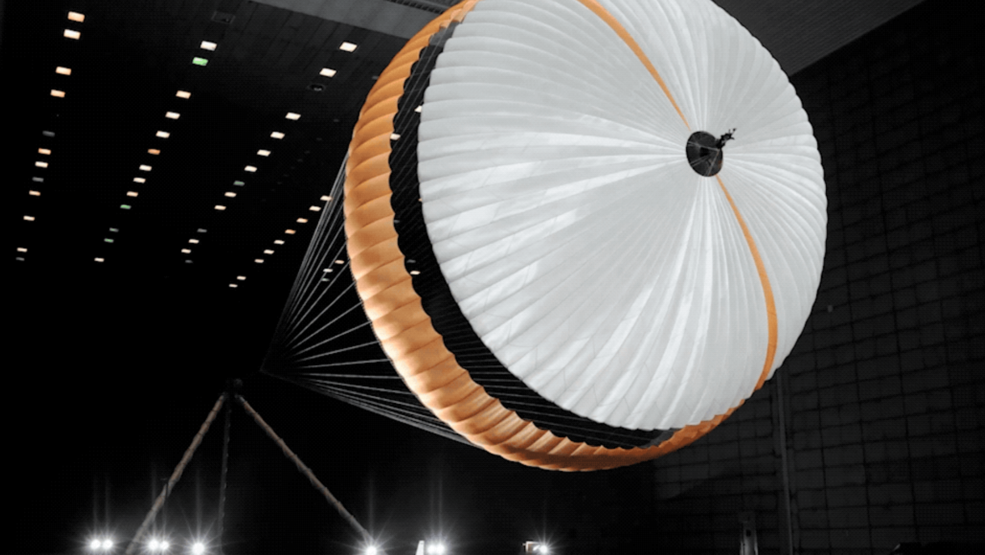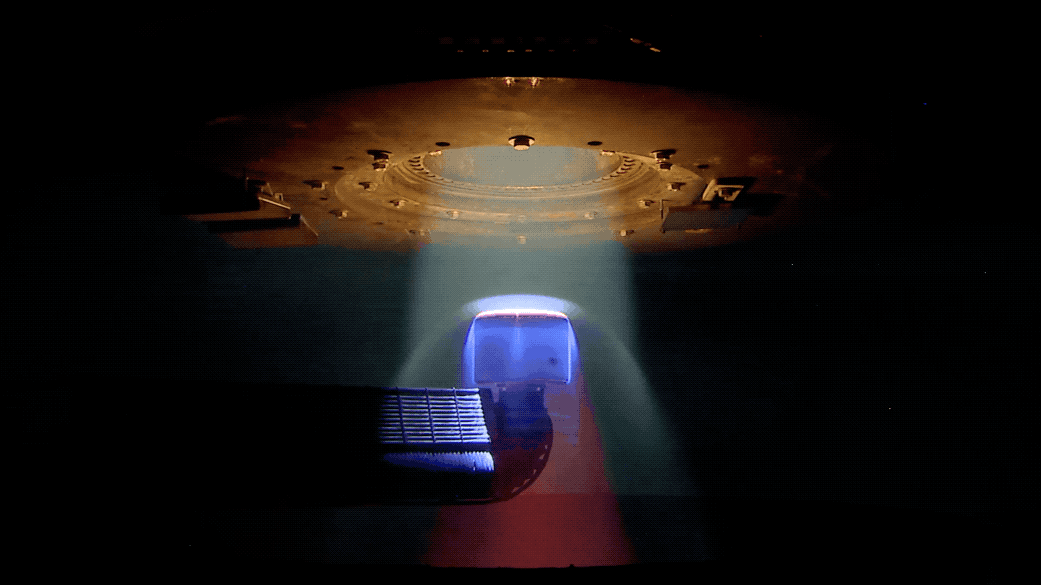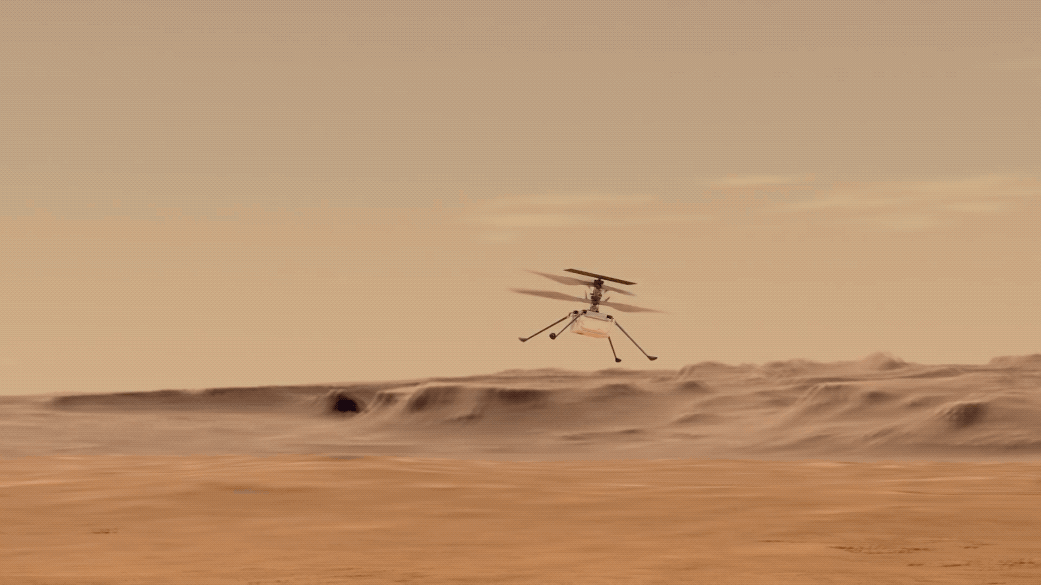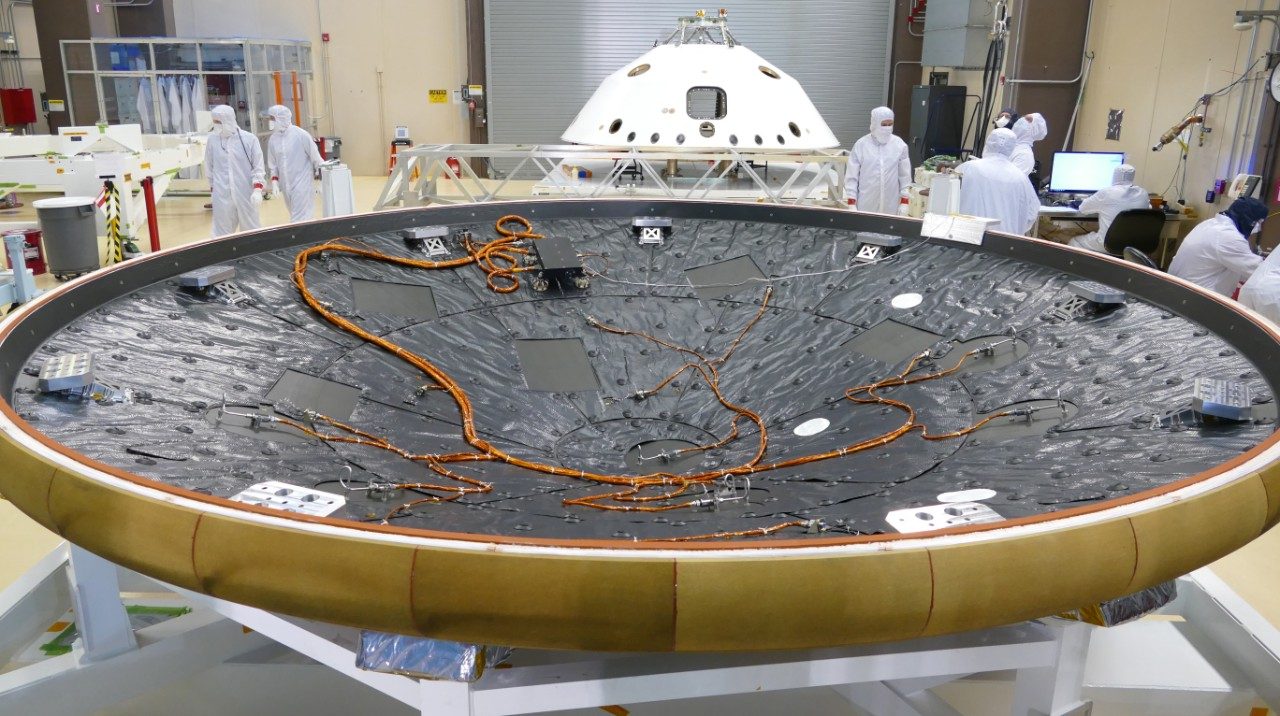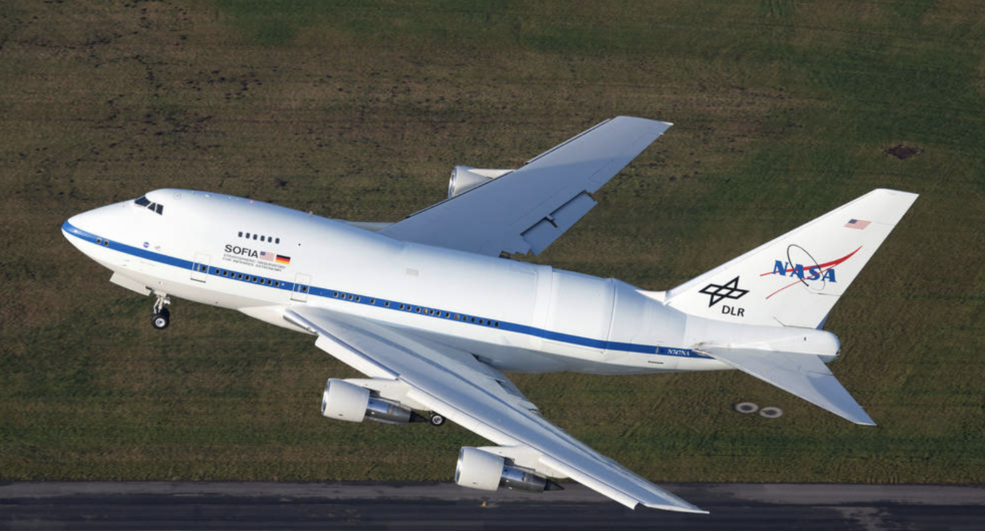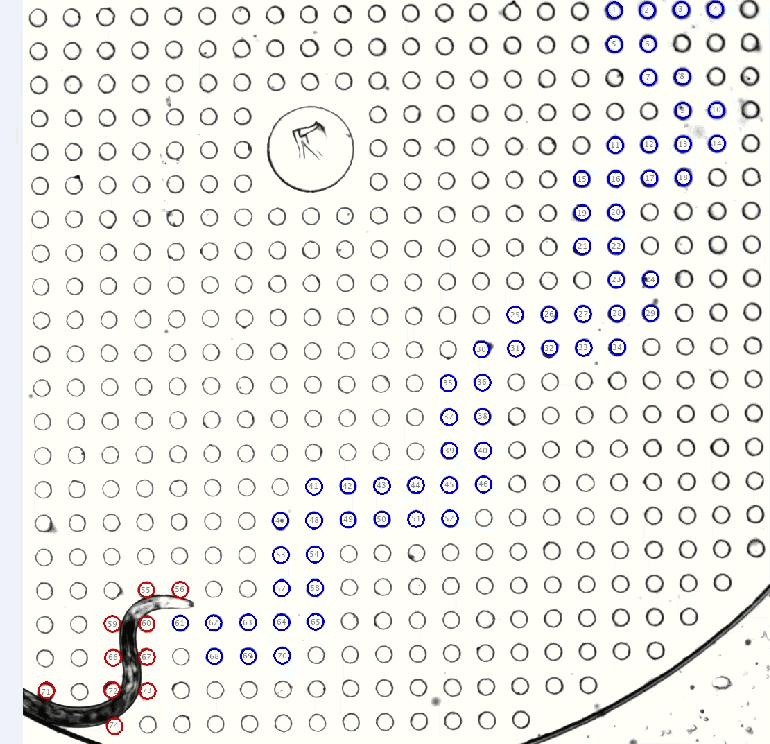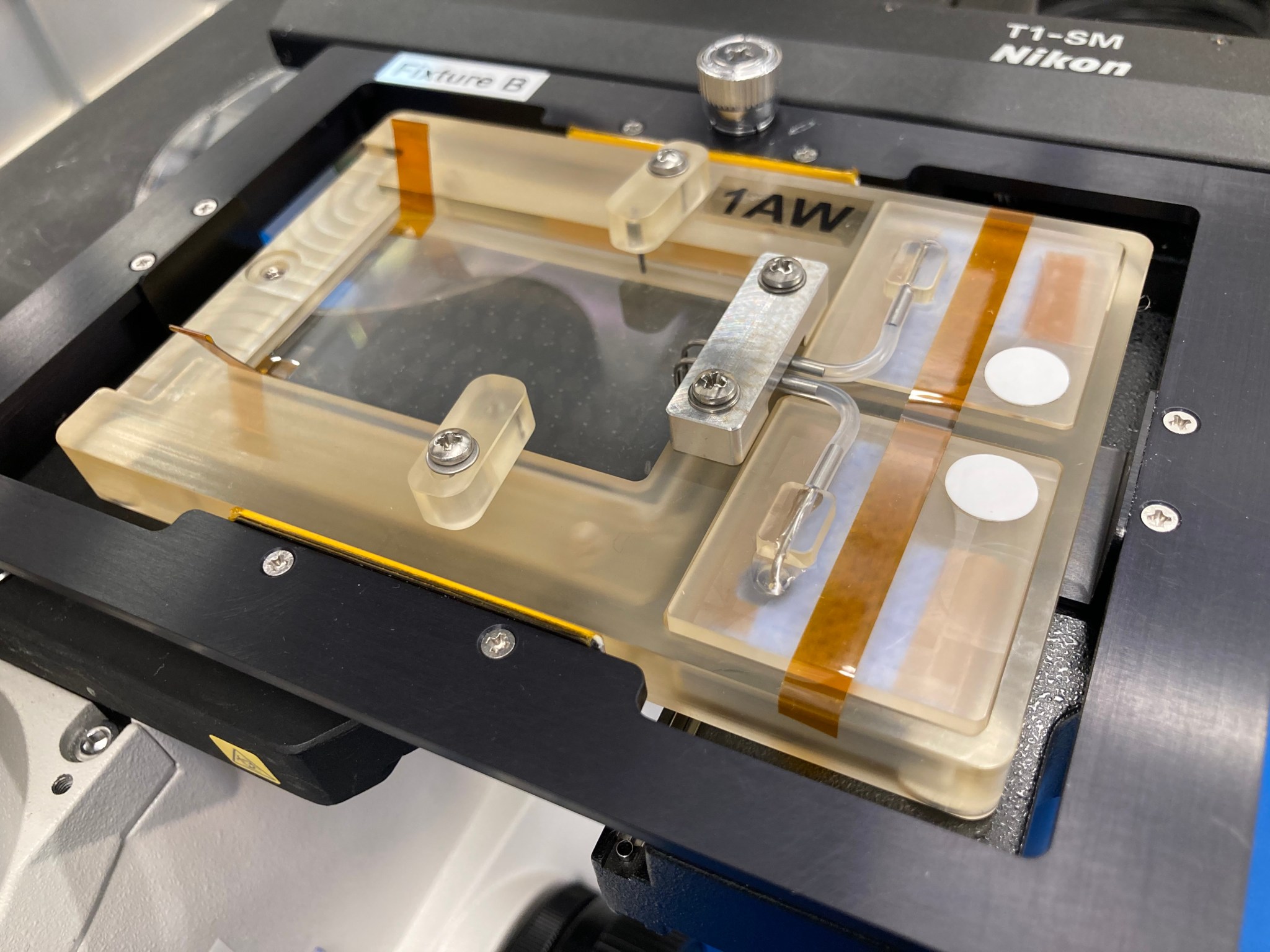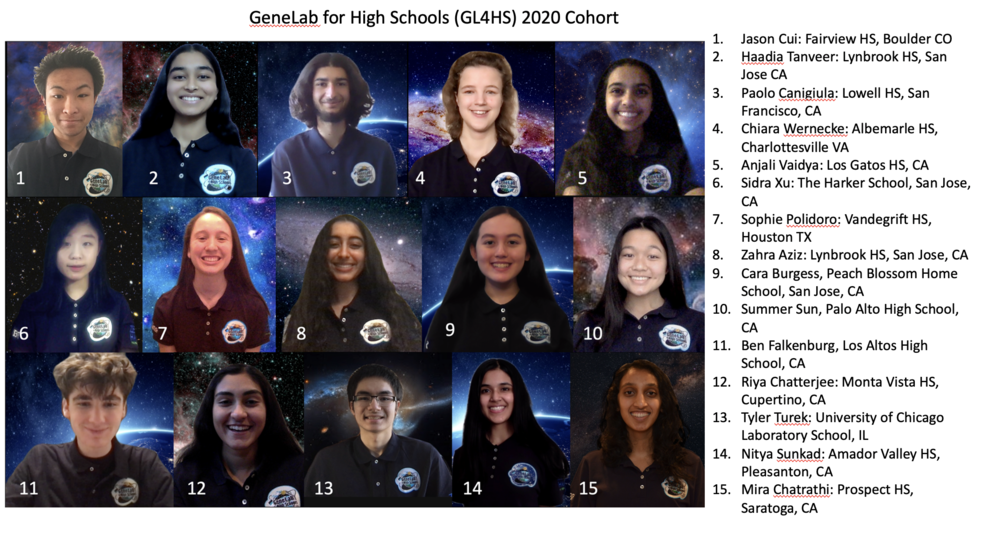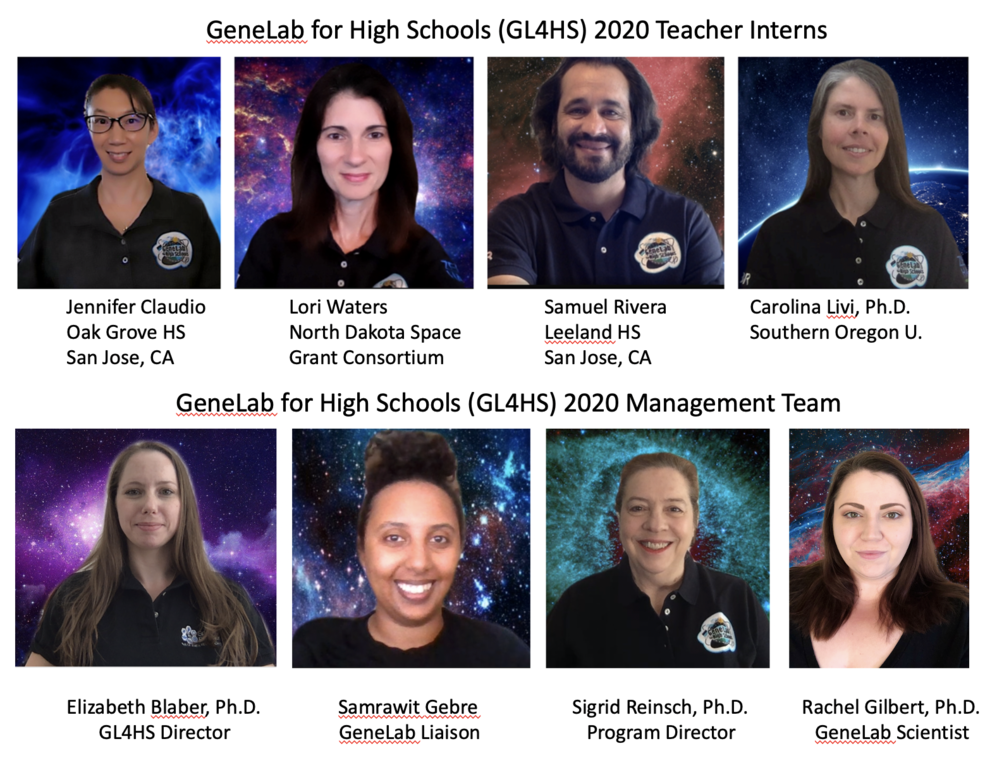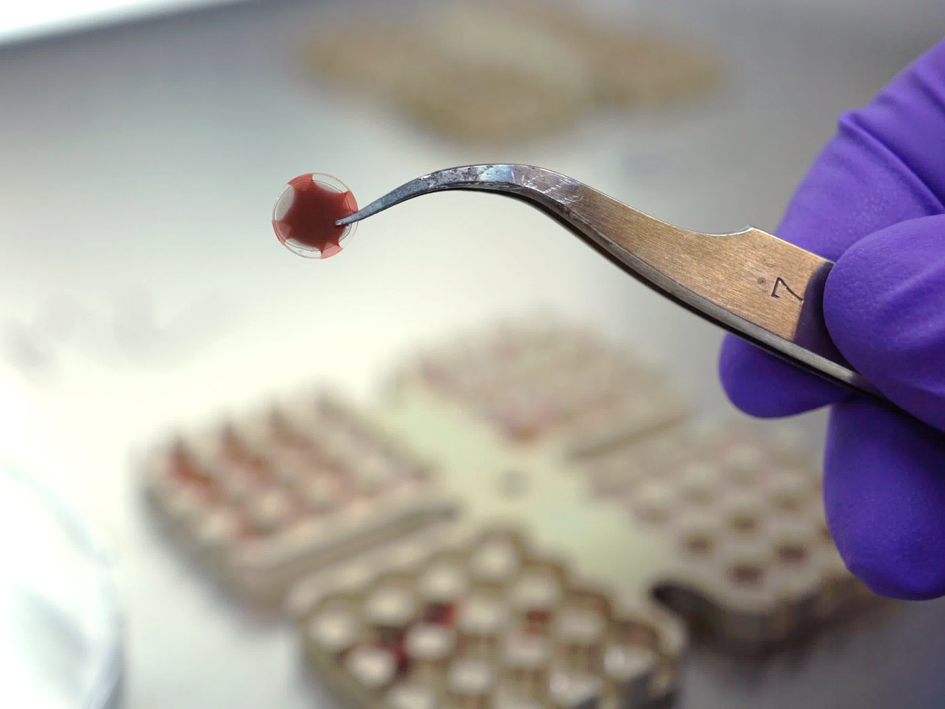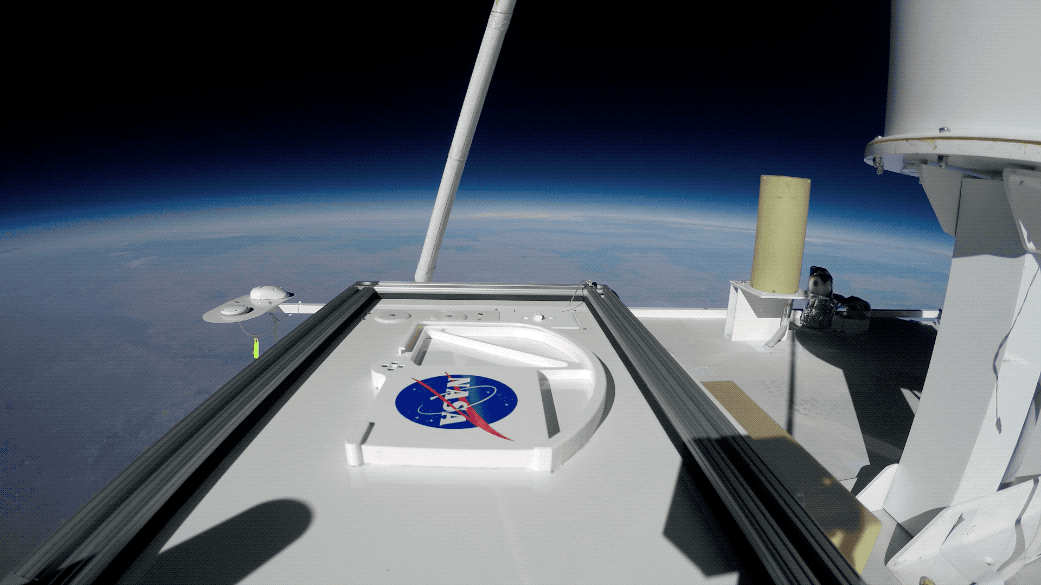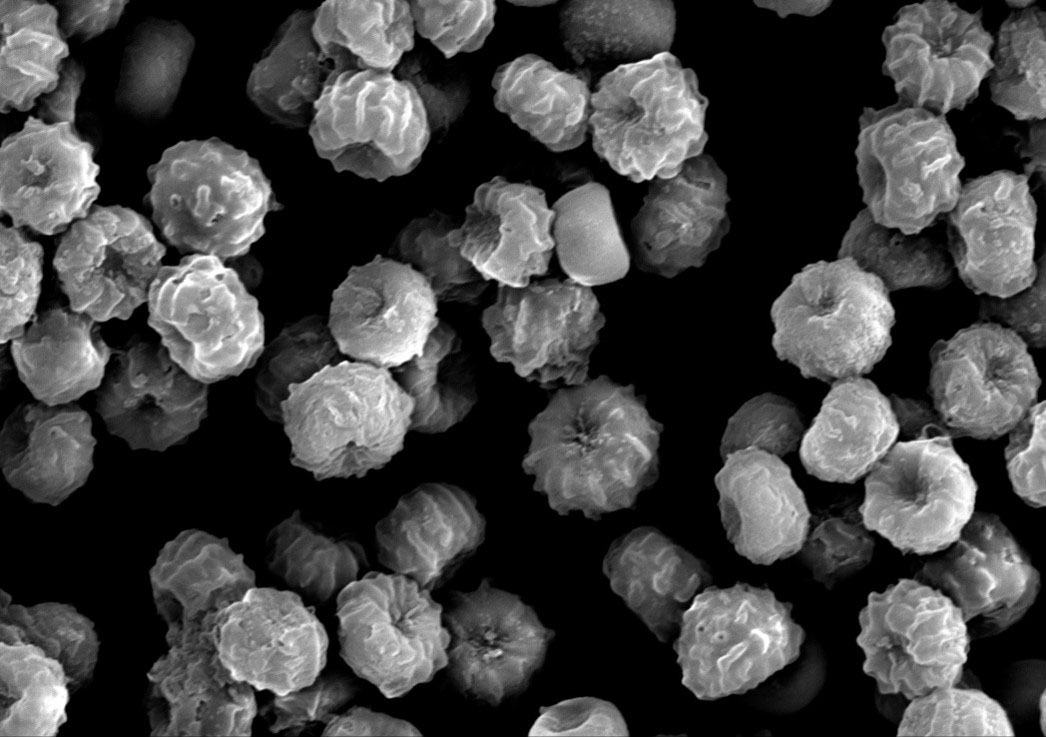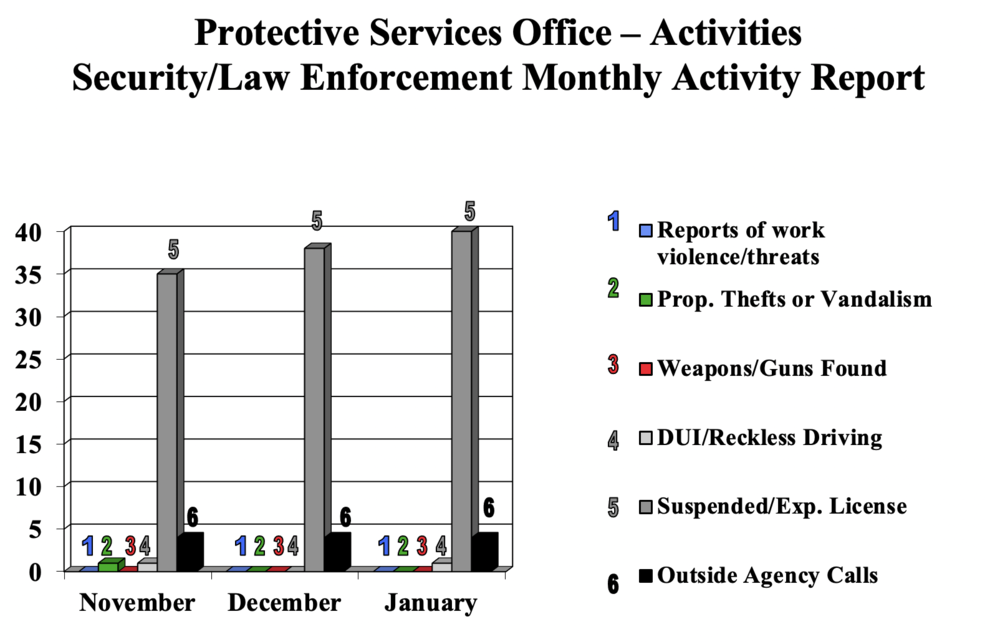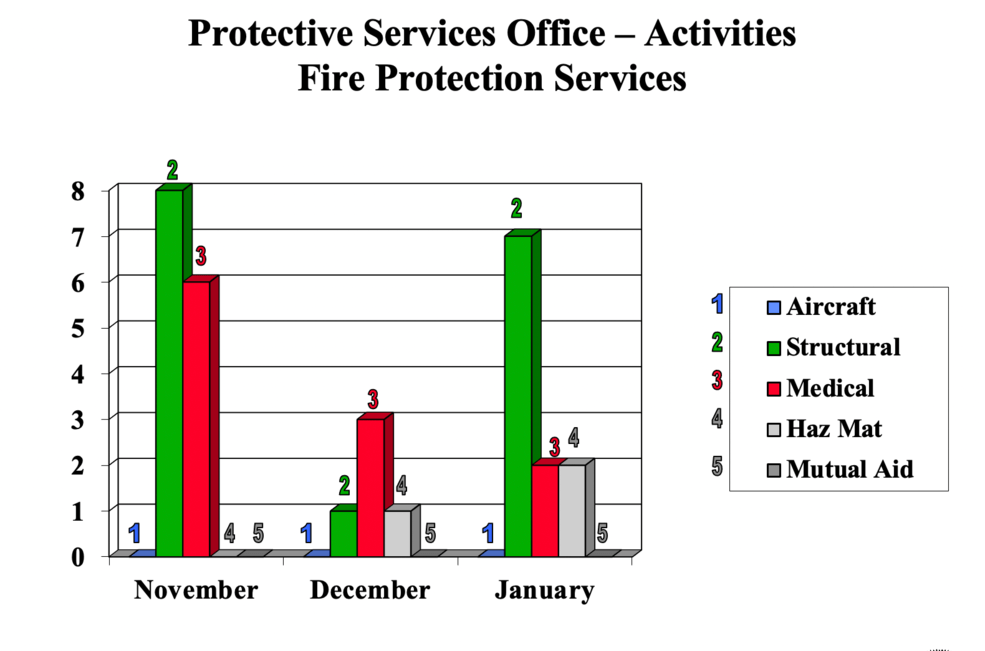February 2021 issue of Ames' newsletter, the Astrogram
Four Ways NASA in Silicon Valley is Helping NASA’s Next Mars Mission
by Rachel Hoover
Groundbreaking technologies aboard NASA’s Mars 2020 mission have roots right here in Silicon Valley. Read on to learn more!
1. Testing a Parachute Made for Mars
The Mars 2020 spacecraft will be coming in hot when it enters the Martian atmosphere on Feb. 18, 2021. The enormous parachute that will help slow its descent was tested in June 2017 in the world’s largest wind tunnel, located in the National Full-Scale Aerodynamics Complex, or NFAC, at NASA’s Ames Research Center in California’s Silicon Valley. The canopy of the parachute will open on Mars at a speed of about 940 miles per hour – but in a much thinner atmosphere than on Earth. For the pre-launch tests in the NFAC, low-speed inflation of the parachute was used to simulate the forces it will need to withstand during its entry into the Martian atmosphere. Made of nylon, Technora and Kevlar fibers, the parachute weighs 180 pounds, measures more than 165 feet in length and opens to an inflated diameter of nearly 51 feet. The NFAC, currently managed and operated by the U.S. Air Force, is the only facility in the world capable of testing the full-size parachute canopy.
2. Shielding the Spacecraft During Its Fiery Descent
The heat shield used to transport the Mars 2020 Perseverance rover through the atmosphere of the Red Planet upon arrival is seen undergoing testing at the Arc Jet Complex facilities at Ames. This heat shield is made with tiles of a material called the Phenolic-Impregnated Carbon Ablator, or PICA, which was invented and developed at Ames and has been used in spaceflight missions for decades. For this mission, the heat shield was built by Lockheed Martin Space in Denver. The heat shield is designed to withstand extreme temperatures while descending through the Martian atmosphere. While traveling at nearly 12,500 miles per hour, or 20,000 kilometers per hour, the surface of the spacecraft collides with the atoms and molecules of the gases in the Martian atmosphere, causing these extreme temperatures. Engineers estimate the spacecraft can withstand temperatures of more than 2,370 degrees Fahrenheit, or 1,300 degrees Celsius, with PICA to protect it while keeping the interior relatively cool, below about 485 degrees Fahrenheit, or 250 degrees Celsius. Using these thoroughly tested materials and designs, NASA strives to make even the most fiery of entries result in a safe landing.
3. Helping the First Mars Helicopter Fly
When NASA’s Ingenuity Mars Helicopter arrives on Mars its mission is to demonstrate the first powered controlled flight on another planet. Ingenuity was designed and developed by NASA’s Jet Propulsion Laboratory in Pasadena, California. The expertise of aeronautical engineers at Ames led JPL to partner with the center and NASA’s Revolutionary Vertical Lift Technology project from the moment work on Ingenuity started. Ames engineers provided performance predictions, computational fluid dynamics analysis, and facility installation studies, as well as system identification, development, and validation. Ames also contributed to the system integration testing of a full-scale Mars helicopter prototype, two engineering development models, and the flight model, which is now attached to the belly of NASA’s Mars 2020 Perseverance rover. Ames continues to partner with JPL to consider future Mars rotorcraft designs.
4. Measuring the Extreme Environment During Landing
Landing on Mars is no easy task, and there’s a lot to learn about the extreme conditions a spacecraft experiences on its way to the surface of the Red Planet. That’s why engineers equipped NASA’s Mars 2020 spacecraft carrying the Perseverance rover with the Mars Entry, Descent, and Landing Instrumentation 2, or MEDLI2, hardware. It’s a suite of sensors on the aeroshell (white backshell and black heat shield structure) that will collect measurements of the pressure and heating environment around the spacecraft. The aeroshell protects the vehicle during cruise, as well as during its fiery descent into the Martian atmosphere. MEDLI2 includes various types of sensors – thermocouples, two kinds of heat flux sensors, and pressure transducers – as well as a data acquisition unit. Engineers at Ames designed and fabricated MEDLI2’s thermocouple plugs and performed rigorous tests on the total heat flux sensors and radiometer for the backshell of the Mars 2020 spacecraft. These instruments, along with others developed at NASA’s Langley Research Center in Hampton, Virginia, will provide the first direct heat flux measurement on the backshell of an aeroshell for a NASA Mars mission and will help improve entry system designs for future robotic and crewed Mars missions.
The landing of the Mars 2020 Perseverance rover is scheduled for 12:55 p.m. PST on Thursday, Feb. 18, 2021. NASA will host virtual news briefings, live shows, and other activities the week of Feb. 15 to discuss events surrounding the landing of its Mars 2020 Perseverance rover. Live landing commentary will begin at 11:15 a.m. on NASA Television, the agency’s website, the NASA app, and several other platforms.
NASA will also provide a live Spanish-language landing commentary show, “Juntos Perseveramos,” on NASA en Español’s YouTube channel. Coverage begins at 11:30 a.m.
NASA’s Next Lunar Rover Progresses Toward 2021 Launch
by Alison Hawkes
NASA’s new water-hunting mission to the Moon, the Volatiles Investigating Polar Exploration Rover, or VIPER, has received agency-level approval to move from formulation into implementation of the final design of the rover. This puts the mission one step closer to launching to the Moon’s South Pole in late 2023.
The decision follows VIPER passing the important preliminary design review milestone in August, in which the mission successfully demonstrated to NASA’s Planetary Science Division and the independent VIPER review team that it can meet all the requirements with an acceptable level of risk within cost and schedule restraints.
The mission will provide the first surface-level mapping of ice and other resources on the lunar surface to further NASA’s goal of establishing a sustainable human presence on the Moon under the Artemis program.
“We’re extremely pleased to see VIPER pass this important milestone,” said Sarah Noble, VIPER program scientist at NASA Headquarters. “Scientific data gathered by VIPER will provide insight into the origin and distribution of water on the Moon, and help us prepare for human exploration by providing important information on the traversability, environment, and resources at the lunar poles.”
Measuring 8 feet (2.5 meters) tall and 5 feet (1.5 meters) in length and width, this mid-sized rover is built for crawling around craters. By pioneering a new kind of wheel motion, NASA is engineering the rover to be agile enough to move through a variety of inclines and soil types – from compacted to fluffy – without getting stuck. Outfitted with sensitive instruments and a drill that can detect water molecules on and below the lunar surface, these components will allow the rover to study many characteristics of the Moon’s polar water over the course of its mission, lasting up to 100 Earth days.
From extreme temperatures to near-real-time rover driving, the VIPER team faces some brand-new challenges operating on the Moon – different from those tackled by previous rover missions to Mars. VIPER will be NASA’s first rover with headlights, capable of exploring permanently shadowed regions of the Moon that haven’t seen sunlight in billions of years.
The extreme swings in light and dark at the poles of the Moon are nothing like those on Earth or Mars and produce extremely long and fast-moving shadows. The solar-powered VIPER must retreat from these advancing shadows as it seeks out the right zones to sample while maintaining communications with Earth. Periods of darkness in this lunar region can last multiple Earth days, so VIPER will periodically park in identified safe havens, where the periods of darkness are shorter. Combining all these constraints makes for complicated route planning.
“We’re now ready to finish the design and operational planning for this rover, and then start building it,” said Daniel Andrews, VIPER’s project manager. “This team has worked incredibly hard, through a pandemic and many other challenges natural disasters to get us to this point – we’re determined now to see it on the Moon.”
VIPER is a collaboration within and beyond the agency. VIPER is part of the Lunar Discovery and Exploration Program and is managed by the Planetary Science Division of NASA’s Science Mission Directorate at NASA Headquarters in Washington. NASA’s Ames Research Center in California’s Silicon Valley is managing the project, leading the mission’s science, systems engineering, real-time rover surface operations and flight software. The hardware for the rover is being designed and built by NASA’s Johnson Space Center in Houston, while the instruments are provided by Ames, NASA’s Kennedy Space Center in Florida, and commercial partner Honeybee Robotics in Altadena, California. The spacecraft, lander and launch vehicle that will deliver VIPER to the surface of the Moon will be provided by Astrobotic in Pittsburgh, who was selected through NASA’s Commercial Lunar Payload Services, or CLPS initiative, delivering science and technology payloads to and near the Moon.
SOFIA Begins First Series of Science Flights from Germany
by Kassandra Bell
NASA’s Stratospheric Observatory for Infrared Astronomy, SOFIA, will conduct its first ever series of science observations from Germany in February and March, 2021. Many of the observations seek to answer fundamental questions in astronomy, including how stars can transform galaxies and what is the origin of cosmic rays in the Milky Way galaxy.
SOFIA, a joint project of NASA and the German Aerospace Center, DLR, recently completed scheduled maintenance and telescope upgrades at Lufthansa Technik’s facility in Hamburg, Germany. Now, the observatory will take advantage of its proximity to science teams at the Max Planck Institute of Radio Astronomy in Bonn and the University of Cologne, which operate the instrument called German Receiver at Terahertz Frequencies, or GREAT, to conduct research flights from the Cologne Bonn Airport.
“We’re taking advantage of SOFIA’s ability to observe from almost anywhere in the world to conduct compelling astronomical investigations,” said Paul Hertz, director of astrophysics at NASA Headquarters in Washington. “This observing campaign from Germany is an excellent example of the cooperation between NASA and DLR that has been the strength of the SOFIA program for over 25 years.”
SOFIA regularly flies to Christchurch, New Zealand, to study objects only visible in the skies over the Southern Hemisphere, and completed one science flight from Germany in 2019. But this is the first time a multi-flight observing campaign will be conducted over European soil. Over the course of six weeks, SOFIA will conduct about 20 overnight research flights that will focus on high-priority observations, including several large programs that were rescheduled from spring 2020 due to the COVID-19 pandemic.
With new COVID-19 safety procedures in place, SOFIA will use its GREAT instrument to search for signatures of celestial molecules, ions, and atoms that are key to unlocking some of the secrets of the universe.
The observations include:
How Stars Affect Their Surroundings
In stellar nurseries like Cygnus X, newborn stars can destroy the clouds in which they’re born. Researchers will use SOFIA to create a map of ionized carbon, a gas the young stars are heating, to better understand this process. Ionized carbon’s chemical fingerprint can determine the speed of the gas at all positions across the celestial clouds. The signal is so strong that it reveals critical details that are otherwise hidden from view deep inside natal clouds. The data may also help explain the source of the mysterious bubble-like structures that were detected by the Herschel Space Observatory and Spitzer Space Telescope but have yet to be fully understood.
Searching for Clues About Cosmic Rays
The team will search for gases that can reveal the presence of cosmic rays, highly energetic charged particles that stream through our Milky Way galaxy. When a hydrogen atom combines with another element, such as argon or oxygen, simple molecules called hydrides are formed, some of which can be used to find cosmic rays. While cosmic rays can be detected directly within our solar system, astronomers know much less about their presence elsewhere in space. By measuring the concentration of hydride molecules, SOFIA’s observations will help researchers understand how common cosmic rays are in different parts of our galaxy, providing clues about the origin of these mysterious particles.
Understanding the Evolution of The Cigar Galaxy, or M82
SOFIA previously found that the Cigar galaxy’s powerful wind, driven by the galaxy’s high rate of star birth, is aligned along the magnetic field lines and transports a huge amount of material out of the galaxy. Now, researchers will study ionized carbon gas, which traces star formation, to learn how this intense star birth and wind are affecting the evolution of the galaxy.
About GREAT
SOFIA’s GREAT instrument works like a radio receiver. Scientists tune to the frequency of the molecule they’re searching for, like tuning an FM radio to the right station. The instrument can also look for changes in signals that provide insights into how stars affect their surroundings, similar to how a radar gun bounces a signal off a moving car to determine its speed.
About SOFIA
SOFIA is a joint project of NASA and the German Aerospace Center. NASA’s Ames Research Center in California’s Silicon Valley manages the SOFIA program, science, and mission operations in cooperation with the Universities Space Research Association, headquartered in Columbia, Maryland, and the German SOFIA Institute at the University of Stuttgart. The aircraft is maintained and operated by NASA’s Armstrong Flight Research Center Building 703, in Palmdale, California.
Tiny Worms Flex Their Muscles for Astronaut Health
by Abigail Tabor
Use it or lose it: It’s a fact of life for muscles – for you and me, for an astronaut, especially, and even for a tiny worm in space.
When people spend long periods of time in space, where gravity doesn’t weigh them down, their muscles can suffer from lack of use. The same is true for a minute organism that helps NASA understand the biology of our bodies away from Earth: a worm so small five of them could lie end to end next to a grain of rice.
Scientists are about to learn more precisely what causes space-related loss of muscle strength in this type of worm, called C. elegans, thanks to a biology experiment starting soon on the International Space Station. This is a step toward treating the same problem in future human explorers, because – small and wiggly as it is – the worm’s muscles work enough like a person’s to tell us some ways human health might be affected on longer missions into deep space.
People have lived and worked on the space station continuously for 20 years now, testing technology and conducting experiments for researchers back on Earth. With this latest study, called Micro-16, scientists will look at changes in the way these worms, bred in microgravity, make and use muscle proteins, and see if they lead to changes in muscle strength.
They’ll also track changes in the worms’ strength and muscle-related genes across seven generations, revealing more about how muscles adapt to microgravity in both the short and long term. Of course, we don’t yet have multiple generations of people living in space to study, so Micro-16 will offer a unique opportunity to study how microgravity affects muscle strength and function.
Space Worms Hit the Gym
So, how do you measure the strength of a worm that is about one-fifth the length of a rice grain? The Micro-16 science team, based at Texas Tech University in Lubbock, Texas, and Ohio University in Athens, Ohio, invented hardware, called NemaFlex, for just that purpose, and they’re about to test it in space for the first time.
Inside a special imaging compartment, the worms will wriggle through a dense forest of miniature, bendable pillars. As they move, a microscope’s camera will record how much each pillar bends away – a measure that reveals the muscle force with which each worm is pushing against them.
The C. elegans worm has been studied in great detail, making it a good candidate for research working out the intricacies of our shared biology. Studying its muscles in the space environment could make the comparison with humans even more informative for questions of astronaut performance – and help us out back on this planet. As the tiny worms muscle in on this spaceflight experiment, researchers hope the knowledge they gain will help reveal the best ways of keeping astronauts strong and new treatments for serious muscle disorders on Earth.
Micro-16 will launch on Northrop Grumman’s 15th commercial resupply mission to the International Space Station. The experiment is sponsored by NASA’s Space Biology program in the Division of Biological and Physical Sciences. The principal investigator is Siva A. Vanapalli of Texas Tech University in Lubbock, Texas. BioServe Space Technologies of Boulder, Colorado, is the payload developer. NASA’s Ames Research Center in California’s Silicon Valley provided technical monitoring and mission management.
Congratulations to the Ames Honorees in the 2020 Federal Employee of the Year Awards
On Feb. 12, seven employees from NASA Ames were recognized at the San Francisco Federal Executive Board, or SFFEB, 2020 Federal Employee of the Year Awards, or FEYA, hosted in San Francisco. The SFFEB represents 160 agencies and 44,500 federal employees in the nine-county Bay Area. The Federal Employee of the Year Awards is the Bay Area federal community’s acknowledgement of the extraordinary accomplishments of the nominees.
The NASA winners for this year are:
Administrative Professionals and Trades
Danella Jenkins, Office of the Director, Code D
Equal Employment Opportunity
Dora Herrera, Plant Engineering Branch, Code JCM
Management
Kenneth Ashford, Office of the Director, Code D
Jules Casuga, Product and Services Development Division, Code ID
Science and Technology
Wayne Johnson, Aeromechanics Office, Code AV
Joseph Rios, Systems Modeling and Optimization Branch, Code AFO
Service to the Community
Ernest Lopez, IT Security Division, Code IS
This year, as with many other events, the awards ceremony was held virtually and can now be watched online. A copy of the awards program also is now available.
Acknowledgement and thank you to the Ames retirees who contributed to the success of this year’s SFFEB FEYA ceremony. Thank you to Kevin Werner and Dennis Koga, who served on the Blue Ribbon Committee. This committee reviewed the finalists and determined this year’s awardees.
Congratulations to our 2020 FEYA winners!
Applications are Open for the GeneLab for High Schools Virtual Summer Training Program: Growing the Next Generation of Scientists
by Sigrid Reinsch
The 2020 Virtual GeneLab for High Schools Summer Training Program, or GL4HS, was successfully completed on July 17, 2020, led by Dr. Elizabeth Blaber of Rensselaer Polytechnic Institute. Fifteen high school students participated from four US time zones during the intensive four-week training program. The students[1] were rising juniors or rising seniors and came from 14 high schools in five states (California, Illinois, Colorado, Virginia and Texas). Four biology instructors[2] also were selected to attend the program to learn how components of the course could be implemented in their classrooms. The program consisted of three core components: learning modules, networking, and a research training project. Students delved into the program from their first day and learned about topics ranging from biology and human physiology in space, to the molecular
biology of gene regulation, signal transduction, and omics analysis methods. In 2020, the program also shifted from a focus on gene arrays to RNA-sequencing using the GeneLab Galaxy analysis platform and datasets from the Rodent Research-6 spaceflight experiment. Students also learned core bioinformatics skills including normalization methods and algorithms, statistical analysis of large-scale datasets, and assigning biological meaning to differential gene expression data. Although the course was planned to take place at NASA Ames, due to the pandemic the course was instead held virtually. There were challenges to be sure, but all 15 students and four teachers attended all four weeks of the program, learned a lot about space biology and bioinformatics and made some lasting friendships and great career connections.
In addition to course lectures presented by Blaber, and teacher trainees Dr. Carolina Livi and Jennifer Claudio, there were guest lectures given by professionals from around the country including NASA scientists and managers, university professors, and industry professionals[3].
GL4HS participated in two virtual meetings with NASA astronauts during the summer. These networking events were held in conjunction with interns from another NASA Space Biology training program for college students – the Space Life Sciences Training Program, or SLSTP. Students met Steven Smith, who had flown on four space shuttle missions and performed seven spacewalks. On the final day of the program, the students met Astronaut Zena Cardman, who is part of the 2017 Astronaut Candidate Class and currently is awaiting a flight assignment.
Finally, students were assigned the task of analyzing a dataset from the GeneLab Database and developing a testable hypothesis and research proposal from their analyses. Self-organized teams of three students chose transcriptomic datasets from NASA’s Rodent Research-6 spaceflight mission including mouse tissues including thymus, lung, skin, liver, and gut. Students normalized and performed statistical analysis followed by pathway analysis on their data using GeneLab’s Galaxy analysis platform in combination with the bioinformatics manual written for them by the GL4HS team. The students worked exceptionally hard on their projects and delved into the scientific literature surrounding their tissues of interest:
TeamThe Migh-T Cells: The Effects of Spaceflight-induced Oxidative Stress on Apoptotic Pathways and Aging in the Murine Thymus
Team Epic-Dermis: Microgravity Effects on Dermal Thickness: An Investigation into Collagen Thickness
Team The Bronchial Bros: Blood Clots in the Lung: The Role of Spaceflight in Altering Vascular Tone and Increasing Risk of Thrombosis
Team Liveration: The Role of Pyruvate Dehydrogenase Kinase 4 (Pdk4) in Liver Lipotoxic and Repair Pathways during Spaceflight
TeamThe Gutsy Girls: The Effects of Spaceflight on Innate Immunity of the Gut: The Role of Angiopoietin-4
On the penultimate day, students presented their background research, analysis of the GeneLab dataset, the hypotheses that they generated and the experiment that they designed to test their hypothesis, to scientists and students at Ames. Staff members, scientists and students at Ames were all extremely impressed by the students’ presentations, the articulation of their science and experimental designs and the ways in which they had grown over the course of the program.
Similarly, students were highly appreciative of the program and all of the things that they learned during the four-week course. Students stated, “This program is the most educational and beneficial program that I have had in high school so far, and I am really thankful for the opportunity,” while Ames scientists said, “Maybe my favorite part of the event yesterday was listening to the students talk about their takeaways. Newfound friendships, intellectual curiosity, courage to ask questions and a desire to keep studying biology.”
Applications for the 2021 virtual GL4HS program currently are open until March 1. For more information about GL4HS and for opportunities for high school teachers to participate, go to https://www.nasa.gov/ames/genelab-for-high-schools
[1]Student Interns: Haadia Tanveer (Lynbrook HS), Nitya Sunkad (Amador Valley HS), Anjali Vaidya (Los Gatos, HS) Sidra Xu (The Harker School), Zahra Aziz (Lynbrook HS), Chiara Wernecke (Albermarle HS), Riya Chatterjee (Monta Vista HS), Cara Burgess (Peach Blossom School), Mira Chatrathi (Prospect HS), Summer Sun (Palo Alto HS), Sophie Polidoro (Vandegrift HS), Paolo Canigiula (Lowell HS), Ben Falkenburg (Los Altos HS), Jason Cui (Fairview HS), Tyler Turek (U. Chicago Laboratory School).
[2]Teacher Trainees: Jennifer Claudio (Oak Grove HS, San Jose, CA), Carolina Livi, Ph.D. (S. Oregon U., Ashland, OR), Samuel Rivera (Leland HS, San Jose, CA), Lori Waters (Foundation Academy, Winter Garden, FL),
[3]Guest Lecturers: Dr. Egle Cekanaviciute (NASA Ames), Dr. Sylvain Costes (NASA Ames), Dr. Cassandra Juran (NASA Ames), Dr. Marie Remigereau (Illumina), Dr. David Smith (NASA Ames), Dr. Ann-Sofie Schreurs (NASA Ames), Dr. Michael Pecaut (Loma Linda University), Dr. Karen Jonscher (University of Colorado), Dr. Afshin Beheshti (NASA Ames), Dr. Pablo Garcia (Circle Pharma), Dr. Jamie Foster (University of Florid
Microbes Survive Balloon Ride to Mars-Like Habitat in the Sky
by Rachel Hoover
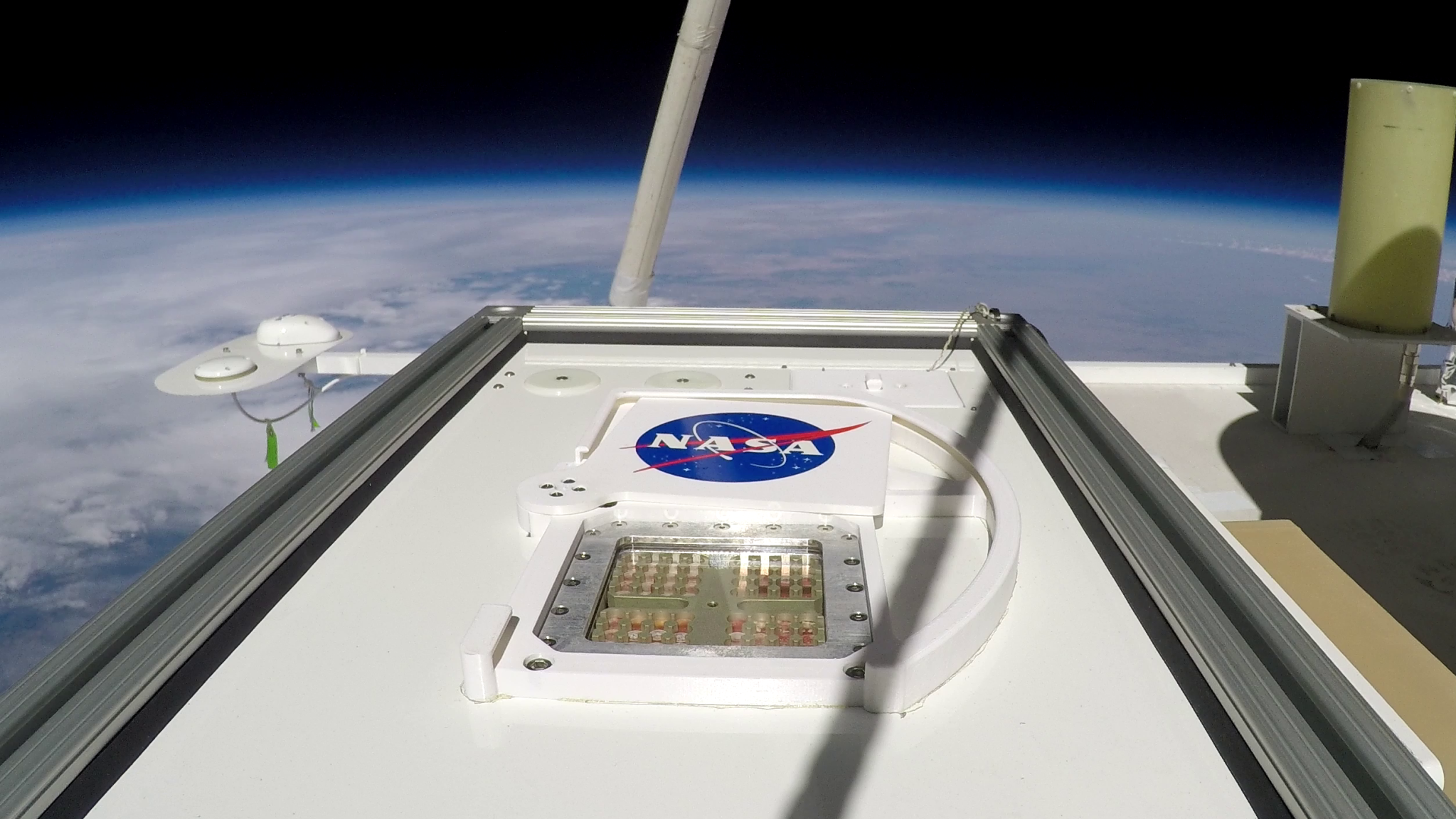
If any Earthling microbes were to stow away onboard a spacecraft to Mars, their odds of surviving the trip and the conditions on the surface would be slim. But with an estimated one trillion species of microbes on Earth, and some of them capable of enduring extreme conditions, scientists want to test if any common microorganisms could actually persist on a Mars mission, and if so, what makes them so tough?
The question is more than academic. NASA is keen to ensure spacecraft don’t accidentally contaminate the Red Planet if we’re ever to discover whether Martian life exists. Fortunately, scientists don’t have to risk going all the way to Mars to get some answers.
About 20 miles above Earth’s surface is a layer of atmosphere that resembles the Martian surface in some key ways. With high levels of radiation, low air pressure, coldness, and dryness, this region can be used as a kind of Martian laboratory in the sky.
“If a microbe can hack it up there, above much of the protective ozone layer, it just might be able to survive – however briefly – on a journey to the surface of Mars,” said David J. Smith, a researcher who studies life in airborne environments at NASA’s Ames Research Center in California’s Silicon Valley.
Smith and a team of collaborating international scientists tested out the durability of life in these extreme conditions by launching a variety of boxed-up microorganisms on a large scientific balloon high into the stratosphere. The Microbes in Atmosphere for Radiation, Survival, and Biological Outcomes Experiment, or MARSBOx, included four different species – the most diverse stratosphere test group yet – including dried and dormant bacteria and fungal spores. Results from the research, recently published in the journal Frontiers in Microbiology, found that two of the four types of microorganisms could temporarily withstand these harsh conditions.
“This research gives us a better understanding of which microbes could linger in environments once assumed to be lethal, like the surface of Mars, and gives us clues about how to avoid unintentionally bringing tiny hitchhikers with us to off-world destinations,” said Ralf Moeller, head of the Aerospace Microbiology Research Group at the German Aerospace Center, or DLR, in Cologne, Germany, and the co-principal investigator of MARSBOx along with Smith.
The Flight and Findings
With no jet or rocket engine roar, on the morning of Sept. 23, 2019, a large NASA scientific balloon calmly and quietly soared into the sky from Fort Sumner, New Mexico, with MARSBOx and millions of tiny, well-secured microbial passengers onboard. Before flight, the samples were adhered onto special quartz discs inside aluminum boxes, designed by collaborators at DLR. The boxes were then filled with a special mixture of gases that mimic the makeup of the thin Martian atmosphere, which is almost entirely made of carbon dioxide.
During the balloon’s ascent and descent, specially designed MARSBOx payload shutters ensured the microbes were shielded in darkness, thereby protecting the samples from harmful solar ultraviolet radiation during their journey to and from the stratosphere. Once they reached their destination at an altitude of about 24 miles, or 127,000 feet, the shutters opened to expose them to the more intense radiative environment at the edge of space. For more than five hours, the microbes were not only exposed to radiation, but also temperatures that averaged -20 degrees Fahrenheit and extremely dry air that was a thousand times less pressure than at sea level. After returning to Earth, DLR scientists then studied the specimens in the lab and found that two of the four species had survived.
Secrets to Survival
Why were these microbes able to endure the combined stressors of the MARSBOx flight in ways the others could not? Survivors included spores of Aspergillus niger, which is a common environmental fungus that can be used to produce a wide range of useful compounds including antibiotics.
“Spores from the A. niger fungus are incredibly resistant – to heat, harsh chemicals, and other stressors – but no one had ever studied whether they could survive exposed in space or under intense radiation like we see on Mars,” said Marta Cortesão, microbiologist at DLR and co-lead author of the first MARSBOx study. “The fact that after their MARSBOx flight we could revive them demonstrates they are hearty enough to endure wherever humans go, even off-planet.”
Scientists theorize these fungal spores were able to withstand desiccation and high radiation by having pigmentation that acts as a sort of sunscreen, or perhaps a structural feature in the architecture of cell membranes that protects their vulnerable insides, much like layers of clothing can protect people from the bitter cold.
The other microbial survivor was the rarer, but harmless bacteria Salinisphaera shabanensis, chosen to fly because of its ability to thrive in Earth’s extremely salty deep-sea brine pools. Some scientists believe possible briny spots on the Red Planet could be promising locations to search for evidence of ancient microbial life.
“This experiment raises a lot of questions about what genetic mechanisms are key to making microbes able to survive,” said Cortesão. “Do they carry ancient evolutionary traits that provide them the ability to withstand harsh conditions, or does the adaptation to their current environment provide protection for many other environmental challenges?”
What Lies Ahead Is Overhead
Scientists hope with further analysis and future experimentation they can determine which genes or genetic mutations are responsible for the survival outcomes and begin to place these microbes on a spectrum of survivability – from most resilient to most sensitive.
In the meantime, the MARSBOx team is completing an analysis of the data from its first-ever onboard dosimeter, also led by the participating DLR scientists, a device that can measure the amount of ionizing radiation the microorganisms were exposed to in-flight. This information will help them tie together the readings from other onboard instruments with the damaging effects of energetic radiation on the microbes. They expect to publish their dosimetry findings later this year.
And in the next few years, the MARSBOx team plans to launch a follow-on flight test from Antarctica, where due to windows in Earth’s protective magnetosphere, the amount of high-energy galactic cosmic rays from space and ultraviolet radiation from the Sun is even closer to Mars-like levels.
“These balloon-flown aerobiology experiments allow us to study the microbe’s resiliency in ways that are impossible in the lab,” said Smith. “MARSBOx provides an opportunity to predict survival outcomes on Mars and help establish the limits of life as we know it.”
MARSBOx is funded by research grants from NASA’s Space Biology and NASA’s Planetary Protection Research Program within the Science Mission Directorate at NASA Headquarters. The MARSBOx team consists of scientists at Ames and the Radiation Biology Department in the Institute of Aerospace Medicine at the German Aerospace Center, DLR, which also designed the sample container and led the microbiological analyses. NASA’s Kennedy Space Center in Cape Canaveral, Florida, provided engineering support. The NASA Balloon Program Office at Wallops Flight Facility on Wallops Island, Virginia, and the Columbia Scientific Balloon Facility in Palestine, Texas, provided additional support.
What are NASA’s Technology Educational Satellites?
by Frank Tavares
NASA’s TechEdSat series of technology demonstrations aims to bring small payloads back to Earth or to the surface of Mars – while pushing the state of the art in a variety of CubeSat technologies and experiments.
TechEdSat is a series of collaborative projects and missions that pairs college and university students with NASA researchers to evaluate new technologies for use in small satellites, or CubeSats. Students do the hands-on work – designing, building, and testing CubeSat spacecraft systems and analyzing the results – for each flight mission, under mentorship of engineers at NASA’s Ames Research Center in California’s Silicon Valley.
CubeSat technologies enable the efficient use of small satellites for a variety of research and technological purposes, and the mission focus of the TechEdSat series is bringing small payloads from orbit back to Earth. Advancing the entry, descent, and landing, or EDL, systems for CubeSats – and sharing new technology with the spaceflight community – will allow more researchers access to cost-effective flight opportunities, leading to more technology testing and science in space.
For example, being able to send CubeSats from orbit to Earth could provide on-demand delivery of samples or hardware from the International Space Station or future space platforms. This technology could also allow future small spacecraft missions to reach the surface of Mars or other worlds in our solar system.
Some of the systems used to control the EDL of a spacecraft are somewhat like driving a car: they use braking, steering, and navigation systems to reach home. Unique to spaceflight is the need to mitigate the intense heating that comes from speeding though the atmosphere.
So far, all of the TechEdSat spacecraft have been intentionally burned up in Earth’s atmosphere at the end of their missions. These initial missions run tests at altitudes up to over 250 miles above Earth, working out the kinks of the first phases of EDL systems to make sure that the systems work and are safe. The ultimate goal is to develop a complete EDL system and eventually to land a CubeSat at a defined location on Earth.
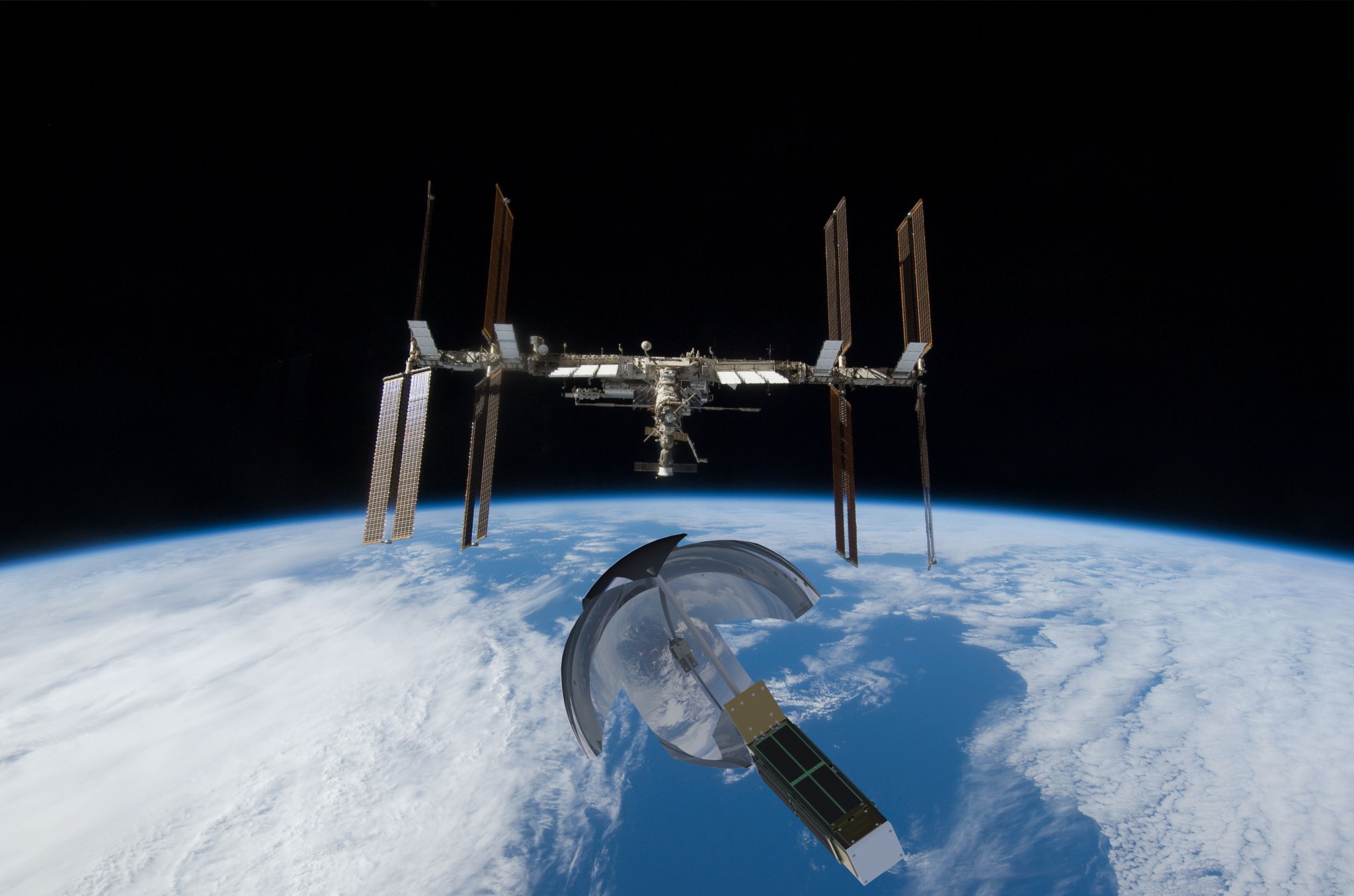
A variety of technologies are developed through TechEdSat missions, including the exo-brake. This new technology is a “wing” that can slow a spacecraft down and eventually allow it to return to the Earth, or potentially other worlds like Mars, in a controlled way. Foil constructions, using plastic and metal materials, origami-folded into designs that can expand, reshape, and be controlled by commands sent via space-to-space communication links. To facilitate this, the TechEdSat series is also advancing innovative solutions for communications in low-Earth orbit.
Current communications methods are expensive and too bulky for CubeSats, and the new technologies could allow researchers to extend these concepts to lunar and planetary missions, extending the capabilities of small satellites past low-Earth orbit. Also, recent innovations have allowed for much larger onboard processing power. Using graphic processor units that use electric analog circuits to mimic the human nervous system, known as or neuromorphic processors, adds much more “thinking” capability in these small boxes.
The next evolution of the TechEdSat project is the Nano-Orbital Workshop platform, or NOW, which includes collaboration from industry and other government organizations all working together at a rapid pace with the ability to have a high cadence of flight missions.
The ability to test these new technologies in space at such a low cost is made possible by the standardized systems inherent to the CubeSat concept, including the system that ejects them into space from larger spacecraft. The CubeSat platform has standard sizes for both satellites and their interfaces with deployment mechanisms, like a household plug and socket. Special dispensers help the CubeSats fit with the deployer on the space station and other vehicles. CubeSats come in various sizes, with the basic unit coming in a cube, roughly the size of a square tissue box and able to fit in your hand. CubeSats use a standard sizing scheme, where each 10-centimeter cube is considered one unit, or U. TechEdSat’s first mission was 1U in size, with recent missions expanding up to 6U.
Ames’ Role
NASA’s Ames Research Center in California’s Silicon Valley is home to the TechEdSat team, chartered to prototype novel solutions to technical spaceflight challenges by providing access to space. Student interns, young professionals, and volunteers supply labor and ingenuity and receive invaluable hands-on experience with real spaceflight hardware. By taking advantage of low-cost flights on balloons, sounding rockets, and orbital opportunities for small satellites, the TechEdSat series makes testing innovative technology in space more accessible. Satellites from the series have been launched directly from rockets, or with a stopover on the International Space Station.
Learn more:
- NASA podcast: Marc Murbach Talks About Building Small Cube Satellites (2017)
- NASA landing page: Ames Engineering Directorate
TechEdSat Missions
TechEdSat-1
TechEdSat-1 launched on the Japanese H-2 vehicle from the Tanegashima Launch Center July 21, 2012, and deployed from the International Space Station Oct. 4, 2012. The 1U CubeSat was the first U.S. CubeSat deployment from the space station. The mission evaluated space plug-and-play avionics, a way for researchers to use standardized systems to facilitate rapid software integration. The safety protocols followed for the jettison from the space station proved invaluable for future missions, and became standard practices for the space station as a launch platform. Communications were performed using amateur-band ultra high frequency receivers on the ground. The CubeSat functioned as intended for approximately six months before atmospheric re-entry May 5, 2013.
For researchers:
- TechEdSat-1 space station experiment page: Technology Education Satellite
- NASA publication: CubeSat 101: Basic Concepts and Processes for First-Time CubeSat Developers (2017)
TechEdSat-2
The TechEdSat-2 mission was launched on the first Antares rocket flight April 21, 2013, and deployed within a day. It wasn’t a standalone satellite, launching alongside Ames’ first PhoneSats. The primary experiment was to determine the utility of using the Iridium satellite constellation as the primary communication link for future nanosatellites, instead of using traditional ground stations. It proved that by using the “ground stations in the sky,” the command-and-control events for future nanosatellites could be greatly improved. The experiment was successfully concluded within 36 hours. Due to the elliptical orbit, the CubeSat re-entered the atmosphere shortly after.
TechEdSat-3p
TechEdSat-3p, weighing 11 pounds, was launched Aug. 3, 2013, on the Kounotori 4 flight mission from the Japanese Aerospace Exploration Agency. It was the first 3U CubeSat deployed from the space station in November 2013. This mission successfully performed the first passive flight test of an exo-brake. This real data could now be compared to calculated aerodynamic models for the very low-density thermosphere. It was the first time an Arduino-based processor was used in the series. The processor was found to function very well in the space radiation environment. Also, more data was acquired over different altitudes for the two-way Iridium satellite constellation communication link – thus adding confidence of this protocol for future CubeSats. The mission re-entered Earth’s atmosphere Jan. 16, 2014.
Learn more:
- NASA story: NASA Launched First Exo-brake Parachute from International Space Station (2013)
For researchers:
- TechEdSat-3p space station experiment page: The Development of On-Demand Sample Return Capability (SPQR)
TechEdSat-4
TechEdSat-4 launched July 13, 2014, weighing 11 pounds and 3U in size, and March 4, 2015, was the first NASA satellite to deploy into orbit from the space station via the NanoRacks CubeSat Deployer. The mission demonstrated improved satellite-to-satellite communications and an upgraded exo-brake system – two new technologies building on previous missions. These developments laid the groundwork for controlling an exo-brake in orbit and more frequent communications with the satellite, leading to more accurate satellite altitude and position predictions. The satellite’s structure, avionics, and payload were custom-designed by the TechEdSat-4 team to utilize its 3U volume. The hardware consisted mostly of off-the-shelf components, allowing for easily reproducible future flight variations. The satellite re-entered Earth’s atmosphere on April 3, 2015 after a four week de-orbit.
Learn more:
- NASA video: Space Station Live: TechEdSat-4 CubeSat Investigation (YouTube, 2014)
For researchers:
- TechEdSat-4 space station experiment page: The Development of On-Demand Sample Return Capability (SPQR)
- International Space Station technical page: NanoRacks CubeSat Deployer facility
- NASA technical fact sheet: TechEdSat-4: Nano-Satellite Series (2015)
- NASA technical page: TechEdSat-Technology Demonstration
TechEdSat-5
TechEdSat-5 launched Dec. 9, 2016, on Japan’s H-II Transfer Vehicle from Tanegashima Space Center in Japan. It deployed from the space station March 6, 2017. Weighing 11 pounds at 3.5 units, TechEdsat-5 used the first modulated exo-brake to target a predetermined re-entry point. Updated radio and global positioning system hardware took the place of wired connections in the satellite, operating as a wireless “data-crossroads” between TechEdSat-5’s key components. This had previously been verified by the team during a suborbital test flight, SOAREX-8, launched from NASA’s Wallops Flight Facility in Virginia. After almost five months of successful operations, the satellite re-entered Earth’s atmosphere July 29, 2017.
Learn more:
- NASA story: NASA’s Exo-brake ‘Parachute’ to Enable Safe Return for Small Spacecraft (2016)
For researchers:
- TechEdSat-5 space station experiment page: Development of On-Demand Sample Return Capability–Small Payload Quick Return
- NASA technical fact sheet: Technical Education Satellite Series: TechEdSat-5
TechEdSat-6
TechEdSat-6 launched to the space station Nov. 12, 2017, aboard the eighth Cygnus cargo resupply flight, from Wallops. Weighing 11 pounds at 3.5 units, TechEdSat-6 was released into low-Earth orbit from the NanoRacks platform Nov. 20, 2017. TechEdSat-6 tested a technology design intended toward an on-demand return of small payloads to Earth. Building off previous missions, TechEdSat-6 used improved software and designs including an updated exo-brake and modulation control. This is the fourth TechEdSat satellite carrying a version of the exo-brake to further demonstrate the necessary elements for guided, controlled re-entry of a CubeSat. On May 14, 2018, the satellite successfully re-entered Earth’s atmosphere.
Learn more:
- NASA feature story about TechEdSat-6: NASA to Test Advanced Space Wireless Network and Device for Returning Small Spacecraft to Earth (2017)
For researchers:
- TechEdSat-6 space station experiment page: The Development of On-Demand Sample Return Capability-Small Payload Quick Return
- NASA technical fact sheet: Technology Educational Satellite Series: TechEdSat-6
- NASA publication: Modulated Exo-brake Flight Testing
TechEdSat-7
The seventh mission in the series launched Jan. 17, 2021, and tested various technologies, including a novel fixed exo-brake. It was designed to pack the most drag into the smallest volume, primarily to rapidly de-orbit from high altitudes. In the future, this could be applied to rendezvous with a piece of debris, then use the exo-brake to dispose of it during reentry. One of the unique features of this new design is the opposing drag device struts, which rely on internal inflation to place them in the proper orientation.
In addition, TechEdSat-7 was the test flight of a new generation of the Tardigrade omni-board which serves as a power, communications, and control board for the TechEdSat series of missions. That board houses the central microprocessor and critical communication functions, the latter of which has greater radiation tolerance. Next, more data and complete statistics are being gathered regarding the efficacy of using the Iridium satellite constellation as a means to more quickly command and control nanosatellites. In addition, a high-power diode/laser communications tracking experiment helps identify the CubeSat, as well as allows optical ground stations to practice operations for upcoming communication systems.
This mission was part of a group of NASA-sponsored nanosatellites that flew on the first commercial launch of the Virgin Orbit air-launched rocket system.
Learn more:
- NASA story: TechEdSat-7’s Flight Mission Begins (2021)
TechEdSat-8
TechEdSat-8 launched to the space station Dec. 5, 2018, aboard the 16th SpaceX cargo resupply flight for NASA and deployed from the space station Jan 31, 2019. The first long 6U CubeSat developed by the team, TechEdSat-8 was designed to fit into a single NanoRacks CubeSat Deployer launch tube. Not only was it the heaviest TechEdSat mission at 13 pounds, it had more functions and capabilities than its predecessors, introducing a 150 watt-hour power system.
The CubeSat carried propulsion experiments and seven transmitters, including the Mars radio and lunar radio experiments, testing out radio communications technology for deep space destinations. By also using the NASA’s Near Earth Network, communication technologies tested during TechEdSat-8 could provide more communication opportunities or a back-up system for upcoming cis-lunar missions. The exo-brake was also designed to be larger, with more control capability than previous missions. The satellite re-entered the atmosphere April 20, 2020.
For researchers:
- TechEdSat-8 space station experiment page: The Development of On-Demand Sample Return Capability (SPQR) Technology Educational Satellite
TechEdSat-10
TechEdSat-10 launched to the International Space Station Feb. 15, 2020, aboard the 13th Cygnus cargo resupply flight for NASA, and deployed July 13, 2020. Building on the foundation provided by TechEdSat-8, this mission took many of those same technologies and enhanced them, with nine processors, a graphics processing unit, and more. TechEdSat-10 again used a long 6U design and featured an improved power system, making it the most powerful CubeSat at that size. In addition, it contained eight radios, four cameras – including a virtual reality camera experiment – and the largest iteration of exo-brake to date. It also featured the second flight of a more complex Tartigrade omni-board.
Learn more:
- NASA webinar: Topics in Advanced Communication and Design in the TES-n Nanosatellite Flight Series: Use of Iridium as a Primary Command/Control Gateway (2020)
- NASA image feature: TechEdSat-10 Deploys from the Space Station (2020)
For researchers:
- TechEdSat-10 space station experiment page: The Development of On-Demand Sample Return Capability (SPQR) Technology Educational Satellite
Partners:
TechEdSat is supported by the participation of students from the following institutions: California Polytechnic State University in San Louis Obispo, California, San Jose State University in California, International Space University in Illkirch-Graffenstaden, France, Smith College in Northampton, Massachusetts, University of Idaho in Moscow, University of California, Davis, University of California, Riverside, and the University of Florida in Gainesville.
TechEdSat is supported by the Ames Engineering Directorate, the Ames Safety and Mission Assurance Directorate, the Ames Chief Technologist Office Center Innovation Fund, Small Spacecraft Technology program, Entry Systems Modeling project, and the National Oceanic and Atmospheric Agency. TechEdSat and the exo-brake are funded by the Entry Systems Modeling project within the Space Technology Mission Directorate’s, or STMD, Game Changing Development program and the NASA Engineering and Safety Center.
TechEdSat-7, TechEdSat-8, and TechEdSat-10 launches were supported by NASA’s CubeSat Launch Initiative’s Educational Launch of Nanosatellites, managed by the Launch Services Program at NASA’s Kennedy Space Center in Florida.






























